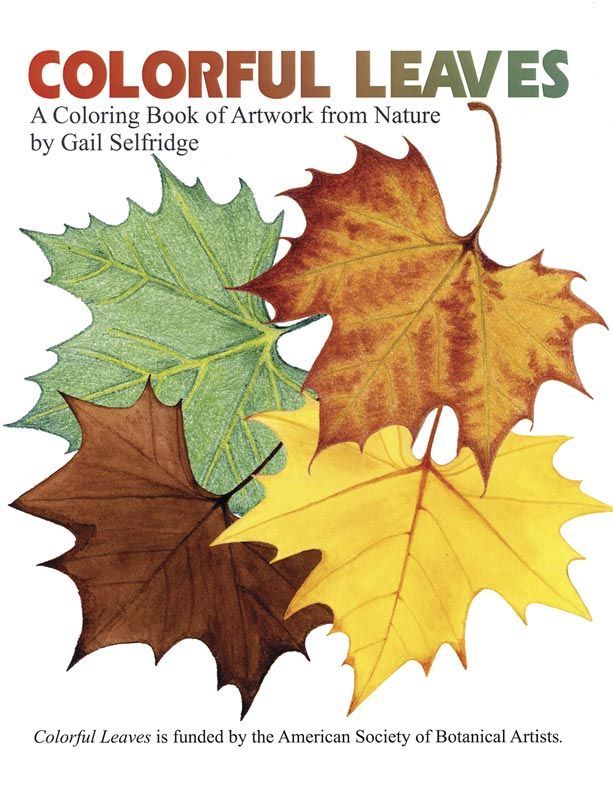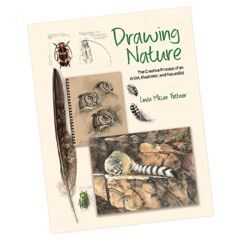The Art and Science of Colorful Leaves
I was educated to be an illustrator in the old school tradition, and even though the professors did not come to class wearing academic robes and require us to rise to attention when they entered the room, I am certain they all entertained such fantasies.
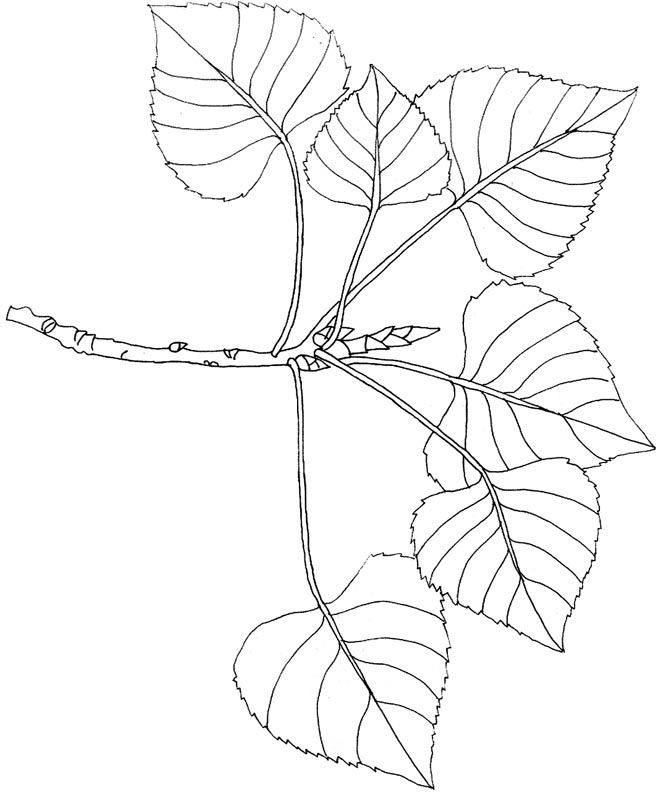
Above & Right: Black & White and Color drawings of Eastern Cottonwood (Populus deltoides) © 2016 Gail Selfridge
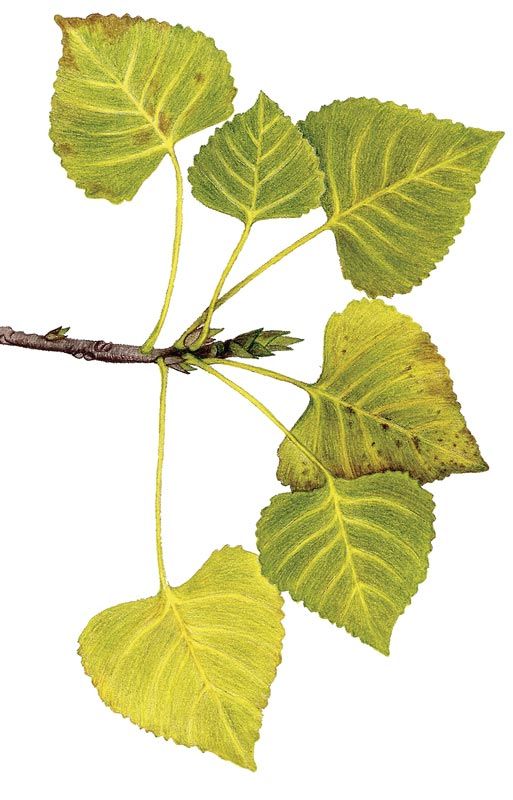
It was rigorous training, long before computers, but even though digital and electronic advances have greatly impacted the printing process and added new dimensions to illustration, much of what was taught remains relevant. For example, the development of a preliminary drawing is still the first step in creating a scientifically accurate illustration. They may be called working drawings, sketches, final sketches, or preliminary drawings but throughout the literature they are always identified as the start of the illustration.
In addition to working as a professional illustrator, I also teach drawing classes but the students are not, as we were back at the university, a captive audience agreeing to be there for a lengthy period of time, pay a lot of money, and eventually work in the field. My classes are part of educational outreach programs and the participants do not have either the time for rigorous training or the inclination to become professional illustrators. They are there to learn about nature drawing as a means of enjoyment.
The initial challenge of working in educational outreach is overcoming drawing phobia, a condition that ranks along side the fears of math and public speaking. At the beginning of each class or workshop, I ask for those who know how to draw to raise their hands, and they all protest and insist that they can’t draw a straight line–whatever that means. Time is an important factor here because classes may only last from one to four sessions, and I quickly saw that given both the objectives and the constraints, what was needed was a way to bypass a lengthy development of drawing skills and study of color theories. But even working at this level an underlying image is required, so I started providing participants with scientifically accurate preliminary leaf drawings in order to move them directly into observing actual leaf specimens and matching/reproducing the color(s) of the specimens.
Colorful Leaves has become available as a pdf download on the ASBA Website along with a second download that includes descriptions and photos of workshops that were given as part of the grant project. Reviews can still be seen on the Amazon site; however, the download is free to everyone and available at:
Please direct any comments or questions regarding the online material to: gls@ksu.edu
Why choose leaves? Well, as specimens they are readily/abundantly available to anybody, free of charge, come in a wonderful array of colors, and can be used to both teach and learn about art materials and techniques as well as science concepts including leaf identification, leaf structure, leaf shapes, leaf venation, photosynthesis, seasonal color changes, etc.
This approach was so successful that I submitted a funding proposal to the American Society of Botanical Artists and received the 2015 Anne Ophelia Dowden Award to create Colorful Leaves, an instructional publication for persons wanting to learn how to create botanical art either for personal use or as part of an educational program. The intention was not to train professional illustrators but rather to create scientifically accurate materials that would serve as tools and encourage both children and adults to observe nature and use drawing plus coloring for recording their observations. The grant ran for one year and the program was created as two separate units.
Part One: the art of Colorful Leaves
Finding the appropriate specimens, creating the line drawings, writing the text, preparing the material for printing, and delivering it to the printer took six months. Colorful Leaves, the publication, combines color inspiration from nature with a selection of reproducible and/or transferable preliminary line drawings. There is also information on how to develop scientifically accurate line drawings from materials found in your own neighborhood, a practice section with step-by-step illustrations matching colors found in nature to colors available in art materials, and a listing of all the colors/materials that were used to create the examples.
Deciding which leaves to include was the first order of business, and they needed to be ones with a wide distribution. Then there was the creation of the line drawings. Each final drawing, while scientifically accurate, did not represent a leaf or branch of leaves that I just walked out and found hanging on a tree or lying on the ground. It is important then to be able to rearrange, reposition, add or subtract details, repair torn edges, over and over at times in order to create a drawing with satisfactory lines and composition. Tracing paper facilitates all of this. Thus the preliminary work was done on tracing paper(s) but which tracing paper, which pen or pencil? Some of the early work was quite beautiful but I would scan it and then print it only to decide that it might not hold up through the printing process. I loved the drawings made with pencils (2H thru 2B) but alas, pens worked best. But then not those beloved ink pens with nibs (left from my university days) but rather technical pens (Pigma Micron and Prismacolor 01 and 005).
I hesitate to use samples of my work as examples because students will always compare their drawings with mine–even though this is their first drawing and, as I remind them, I have been doing this for years. But eventually, the decision was made to include some finished drawings along with a list of the materials (colors and brands) that were used. This turned out to be a good decision and very helpful to users of the materials because it gave them a starting point, not to copy, but upon which to build.
Using the line drawings in Colorful Leaves
In addition to personal use, the line drawings of Colorful Leaves can be used in a classroom setting or educational outreach program and there are several different methods for working with the images:
1. Work can be done directly on the pages of the book (Exact Vellum Bristol) using crayons, colored pencils, and graphite pencils. For watercolors, I recommend transferring the images to watercolor paper and to bleed proof paper for markers.
2. The images can be reproduced on a copy machine and coloring can be done on the copies. Permission is given for making copies of these line drawings for personal use.
3. Images can be transferred to suitable art paper on which the coloring is then done. This method preserves the original drawings, and images can be repeatedly transferred for experimenting with different papers and various techniques including colored pencils, watercolors, crayons, graphite pencils, markers, pen, and ink.
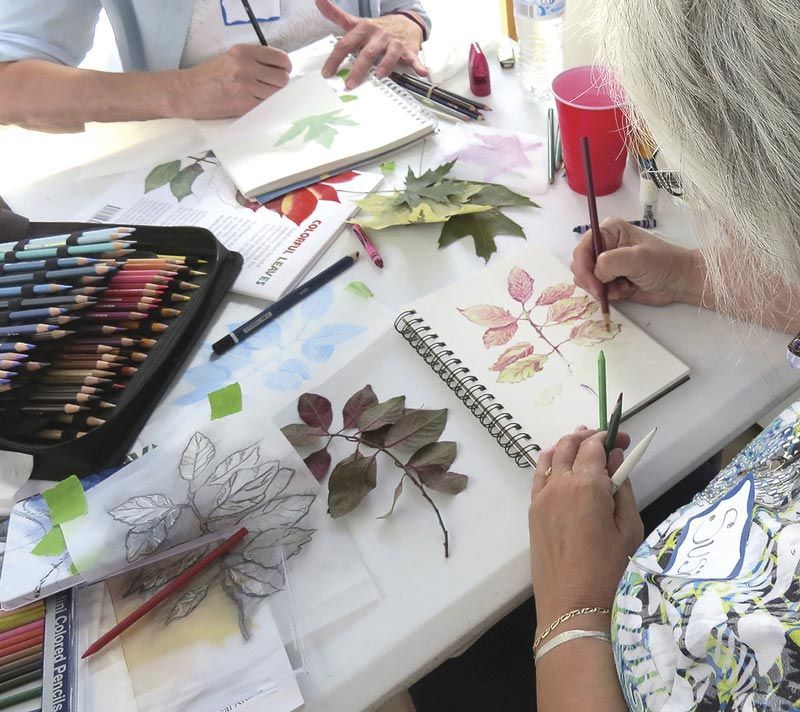
A Colorful Leaves workshop. Photo © 2016 Dorothy DePaulo
Part Two: the science of Colorful Leaves
Part two was the presentation of workshops using the text and images featured in the publication and ultimately a report of the program’s success at the annual ASBA national conference.
The second half of the year was spent managing the distribution, communicating with reviewers and workshop presenters, and compiling the results of these efforts. Review copies were sent, and to promote the use of Colorful Leaves as part of an educational outreach activity, complimentary copies were made available to ASBA and GNSI members in exchange for giving an educational program and then preparing a short description of the event and photos. Fourteen respondents agreed to participate: five in California; two in Pennsylvania; one each in Florida; Massachusetts; Colorado; Nebraska; New York; Toronto, Ontario, and Montevideo, Uruguay.
The workshop activities were quite varied and interesting and no two were alike. Some workshops were directed to adults, others to children. There was no curriculum that accompanied the use of the books nor instructions for how workshops should be given. Persons were free to read the text and decide for themselves how best to present the material for their group. There were fourteen presenters and fourteen different and creative ways for connecting workshop participants with science, nature, and botanical drawing/coloring, and all of the results were amazing.
Leaf shape, leaf identification, photosynthesis, and seasonal color changes were just a few of the science topics covered. One group that worked with children used the Colorful Leaves material as a starting point for exploring nature and went on to make nature journals that included drawings of animals and plants in their own neighborhood. A group of adults planned to continue working after the event and share the materials with their grandchildren. Yet another chose to continue over the year and make personal notebooks recording leaf colors as they changed with the seasons.
Although each workshop presenter had six copies of Colorful Leaves with which to work, a workshop or presentation could be given using only one copy of the publication.
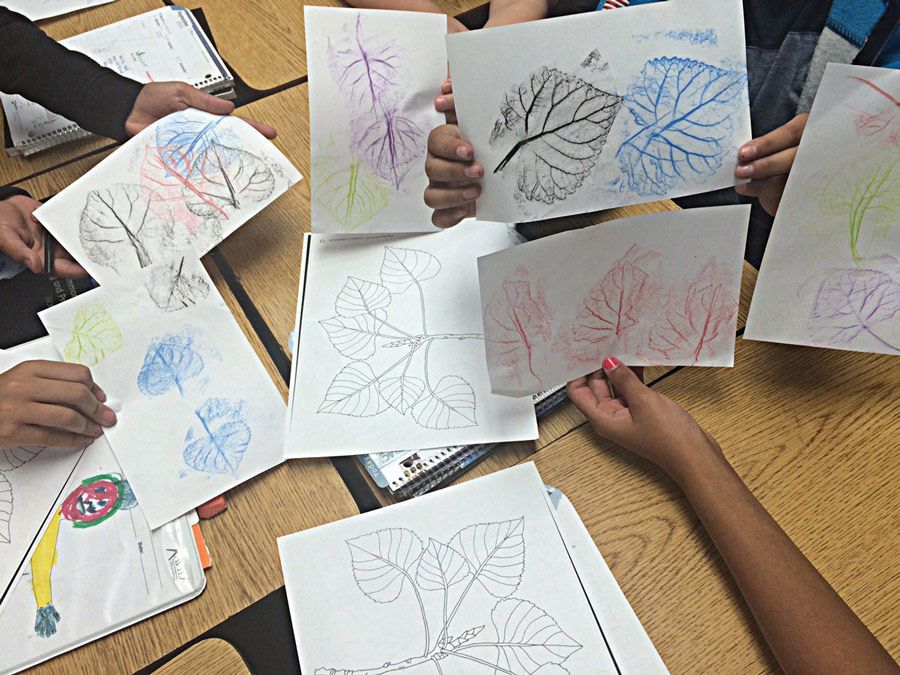
Above & Right: Teaching math concepts using Colorful Leaves. Photo © 2016 Erika Kvande
Below: Results of the Colorful Leaves workshop in Uruguay. Photo © 2016 Gabriela
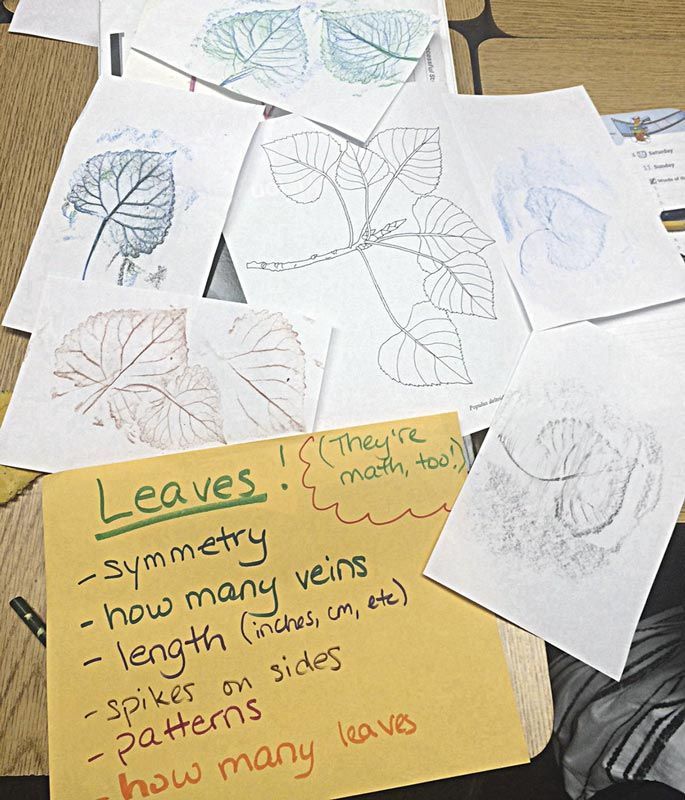
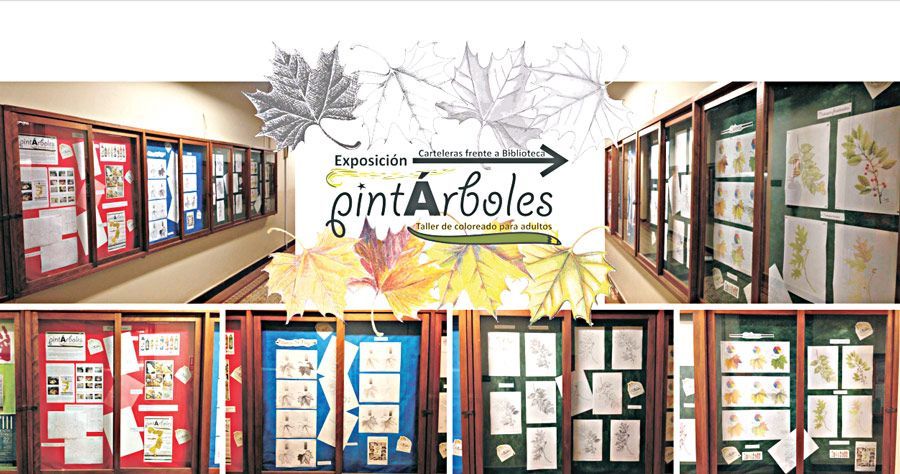
Colorful Leaves:
a coloring book of artwork from nature along with reviews can be seen at www.amazon.com/Colorful-Leaves-Coloring-Artwork-Nature/dp/0974669016
(Ed. Note: Amazon no longer sells the book, but you can download digital versions from the ASBA.)
Long-term benefits
Long before studying illustration at the university, I enjoyed working with plants, animals, and drawing. There were no video or computer games. In fact, there were no computers. We had to amuse and entertain ourselves and I learned to do that by exploring nature and drawing. The purpose of the Colorful Leaves program was not only to connect individuals to nature through drawing but also to encourage them to develop a lifetime interest in the natural world that exists all around us because our very existence relies on the plants and other animals. It was rewarding to see the results of the workshops, and the success of the grant was greatly increased by the presenters and the workshop activities.
________
Please direct any comments or questions regarding the online material to gls@ksu.edu
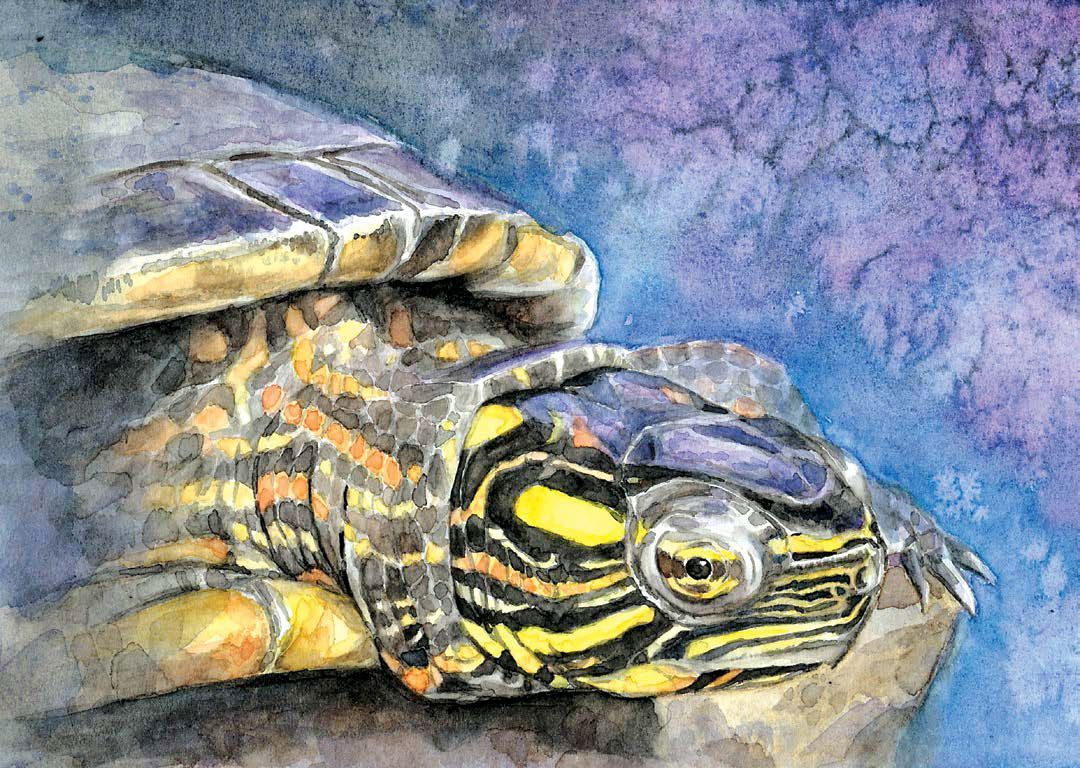
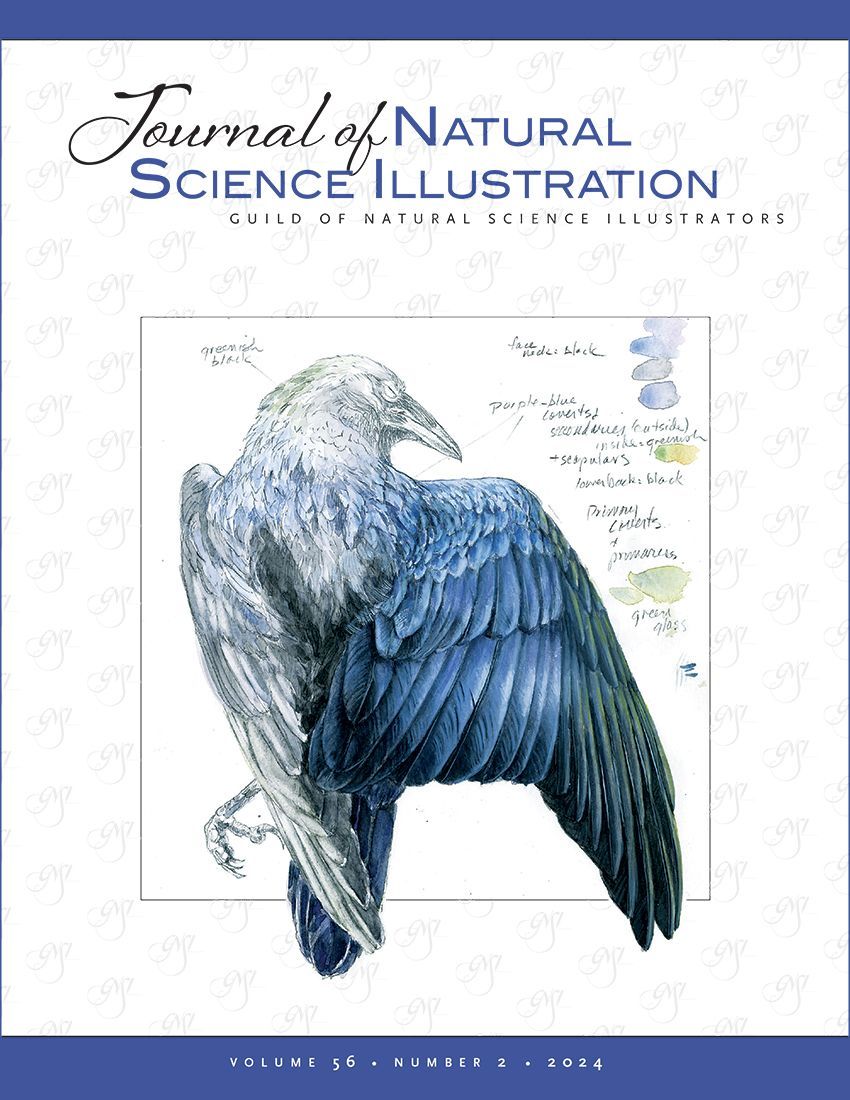
All Content © 2025 | Guild of Natural Science Illustrators
℅ Gilbert & Wolfand, PC
2201 Wisconsin Avenue NW, Suite 320
Washington, DC 20007
Privacy Policy | Image Use Policy
Website powered by Neon One
